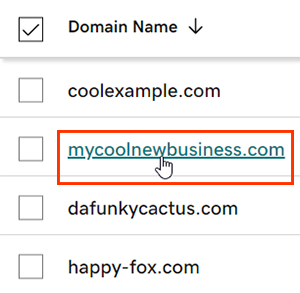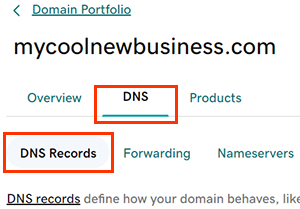Add or edit an A record
Connect your domain to your website by adding an A record to your DNS zone file when your domain is using GoDaddy nameservers. A records, or address records, are the most fundamental type of DNS record and are used to indicate the IP address of a domain. The most common A record is for the root domain, like mycoolnewbusiness.com, and typically connects the domain to a website.
Changes to an existing A record could cause your website or email service to stop working properly.
- Sign in to your GoDaddy Domain Portfolio. (Need help logging in? Find your username or password.)
- Select an individual domain to access the Domain Settings page.

- Select DNS to view your DNS records.

- Select Add New Record and then select A from the Type menu.
- Enter the details for your new A record.
- Name: The hostname or prefix of the A record, without the domain name. Enter @ to put the record on your root domain, or enter a prefix, such as blog or shop, to create a subdomain that points to an IP address. The Name must follow these guidelines:
- Periods (.) are allowed but not as the first or last character
- Consecutive periods (…) are not allowed
- Cannot begin or end with a hyphen (-)
- 63 characters in a row not separated by a period (.)
Example: 63characters.63characters.coolexample.com
- 255 characters maximum
- Value: The IP address the record corresponds to. This is commonly the IP address for a hosting account.
- Select Add another value to add more IP addresses to this record.
- TTL (Time to Live): The amount of time the server should cache information before refreshing. The default setting is 1 hour.
- Name: The hostname or prefix of the A record, without the domain name. Enter @ to put the record on your root domain, or enter a prefix, such as blog or shop, to create a subdomain that points to an IP address. The Name must follow these guidelines:
- (Optional) Select Add More Records to add multiple DNS records at the same time. If you change your mind, select
 Delete to remove any records that haven't been saved yet.
Delete to remove any records that haven't been saved yet. - Select Save to apply your settings.
- If your domain has Domain Protection, you'll need to verify your identity. If you've had 2-step verification (2SV) turned on for at least 24 hours, enter the code we sent via SMS, or enter the code from your authenticator app. Otherwise, enter the one-time password we sent to your registrant email address.
- Select
 Edit next to the record you'll be editing.
Edit next to the record you'll be editing. - Enter the details for your A record.
- Name: The hostname or prefix of the record, without the domain name. Enter @ to put the A record on your root domain, or enter a prefix, such as blog or shop, to create a subdomain that points to an IP address. The Name must follow these guidelines:
- Periods (.) are allowed but not as the first or last character
- Consecutive periods (…) are not allowed
- Cannot begin or end with a hyphen (-)
- 63 characters in a row not separated by a period (.)
Example: 63characters.63characters.coolexample.com
- 255 characters maximum
- Value: The IP address the record corresponds to. This is commonly the IP address for a hosting account.
- Select Add another value to add more IP addresses to this record.
- TTL (Time to Live): The amount of time the server should cache information before refreshing. The default setting is 1 hour.
- Name: The hostname or prefix of the record, without the domain name. Enter @ to put the A record on your root domain, or enter a prefix, such as blog or shop, to create a subdomain that points to an IP address. The Name must follow these guidelines:
- Select Save to apply your settings.
- If your domain has Domain Protection, you'll need to verify your identity. If you've had 2-step verification (2SV) turned on for at least 24 hours, enter the code we sent via SMS, or enter the code from your authenticator app. Otherwise, enter the one-time password we sent to your registrant email address.
Most DNS updates take effect within an hour, but could take up to 48 hours to update globally.
Related steps
- Delete an A record from your zone file if you no longer need it.
- Ready to build your own website? Take a look at our do-it-yourself Websites + Marketing features.
More info
- Create a template to quickly assign DNS records to your domains.
- Keep your domains organized with folders and preset profiles.